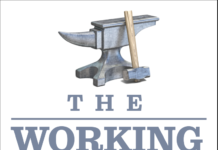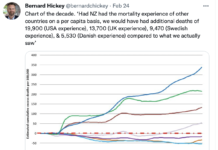.
Source: Radio NZ – Detroit files for bankruptcy
.
America’s grand experiment in neo-liberal capitalism has claimed it’s third bloody sacrifice; Detroit (after Jefferson County, Alabama, and Stockton, California).
Detroit now owes US$18.5 billion in debt. It has declared itself officially bankrupt – the largest US city ever to do so.
There are no doubt several reasons for Detroit’s current economic decline and its inevitable urban decay, but it is a dying city nevertheless,
The governor painted a picture of a city in collapse. Citizens wait 58 minutes for the police to respond to calls, compared to a national average of 11 minutes. Only a third of ambulances were in service in the first quarter of 2013. There are approximately 78,000 abandoned buildings in the city. The unemployment rate had nearly tripled since 2000 and the homicide rate was at its highest level in 40 years, he said. Detroit is unable to meet its most basic obligations to its residents, let alone its creditors.
Source: UK Guardian – Detroit becomes largest US city to file for bankruptcy in historic ‘low point’
“Jobs in the industry have dropped by 40 percent since 2000, from 1.3 million to 800,000“, wrote Evan Soltas for Bloomberg.
Michael Snyder, writing in theeconomiccollapseblog.com, posted 17 Facts About The Decline Of The U.S. Auto Industry That Are Almost Too Crazy To Believe,
#1 The average age of an automobile in the United States has gone up more than 50% since 1990 and is now sitting at an all-time record of 10.8 years. The average length of a marriage in the United States that ends in divorce is only 8 years.
#2 Germany made 5.5 million cars in 2010. The United States made less than half that (2.7 million).
#3 When you add up salary and benefits, the average auto worker in Germany makes $67.14 an hour. In the United States, auto workers only make $33.77 an hour in salary and benefits.
#4 Back in 2000, about 17 million new automobiles were sold in the United States. During 2011, less than 13 million new automobiles were sold in the United States.
#5 Do you remember when the United States was the dominant manufacturer of automobiles and trucks on the globe? Well, in 2010 the U.S. ran a trade deficit in automobiles, trucks and parts with the rest of the world of $110 billion.
#6 Japan builds more cars than anyone else on the globe. Japan now manufactures about 5 million more automobiles than the United States does.
#7 In 2010, South Korea exported approximately 12 times as many automobiles to us as we exported to them.
#8 According to the New York Times, a Jeep Grand Cherokee that costs $27,490 in the United States costs about $85,000 in China thanks to new tariffs.
#9 U.S. car companies are spending hundreds of millions of dollars building shiny new automobile factories in China.
#10 In 1970, General Motors had about a 60 percent share of the U.S. automobile market. Today, that figure is down to about 20 percent.
#11 The combined U.S. market share of the “Big Three” American car companies fell from 70% in 1998 to 53% in 2008.
#12 Detroit was once known as the “Motor City”, but in recent decades automobile production has been leaving Detroit at a staggering pace. One analysis of census figures found that 48.5% of all men living in Detroit from age 20 to age 64 did not have a job during 2008.
#13 Today, only Chrysler still operates an automobile assembly line within Detroit city limits.
#14 Since Alan Mulally became CEO of Ford, the company has reduced its North American workforce by nearly half.
#15 Today, only about 40 percent of Ford’s 178,000 workers are employed in North America, and a significant portion of those jobs are in Canada and Mexico.
#16 The average Mexican auto worker brings in less than a tenth of the total compensation that a U.S. auto worker makes.
#17 In the year 2000, the U.S. auto industry employed more than 1.3 million Americans. Today, the U.S. auto industry employs about 698,000 people.
Item #9 is off particular relevance to New Zealand, because we are doing precisely the same thing;
U.S. car companies are spending hundreds of millions of dollars building shiny new automobile factories in China.
As Forbes posted in May 2010, in an article U.S. Companies That Invest Big In China,
General Motors and Volkswagen have invested billions in China, starting more than a decade ago. Ford is rushing to catch up by adding production capacity and expanding its dealer network in China. Ford and its joint-venture partner, Chang’an Ford Mazda Automobile, plan to start producing next-generation Ford Focus models at a new, $490 million plant in Chongqingin 2012.
Essentially, the United States car manufacturing industry has been busy exporting it’s production facilities and jobs to other low-wage countries – China and Mexico to give two examples.
Here in New Zealand, we’ve done pretty much the same thing; gutted our manufacturing sector by busily exporting it to China (and elsewhere) where wages are low, in comparison to New Zealand workers*,
.
Source: Radio NZ – Rakon blames job cuts on high dollar
.
This, essentially, is the end-result of eliminating tariffs with so-called “free trade” agreements. Except, these agreements are not “free” at all. They cost jobs.
For every pair of cheap Skellerup “Red Band” gumboots you and I buy at The Warehouse – New Zealander’s jobs were sacrificed,
The first pairs of Red Band Men’s gumboots retailed for twenty five shillings and 11 pence. Red Band gumboots continued to be made at Skellerup’s Woolston factory in Christchurch until the late 1980s when economic considerations forced the company to move production offshore.
So how cheap are those gumboots made in China?
The economic cost of people out of work is astronomical: $805,759,000 for the 2012/13 period alone (Unemployment Benefit and Emergency Benefit (M63) – Vote Social Development – Estimates of Appropriations 2013/14)
The social cost is beyond a dollar value.
And yet, it was not always like this. Once upon a time, we had full employment.
In 1973, the numbers of registered unemployed (not including overall jobseekers) stood at 2,321. (source)
By June 2008 the number of registered unemployed (not including overall jobseekers) had increased to 17,710. (Pre Global Financial Crisis recession.)(source)
Forty years later, by June this year, after de-regulation, free trade treaties, abolition of tariffs, and the dismantling employment legislation and the trade union movement, the number of registered unemployed (not including overall jobseekers) increased to 48,438. (IBID)
The actual numbers of jobless, according to regular Household Labour Force Surveys, is much higher (currently at 146,000). (source)
It could be said that the cost of those cheap, foreign-made Redband gumboots (and other consumer goods) is costing taxpayers $805,759,000 per annum.
Conformist middle class consumers, if they read this, would probably shrug and dismiss it from their minds. Such matters as Detroit and the pernicious consequences of the “free” market (which, as I have shown, is not “free”) on our employment, economy, and social fabric is beyond their ken.
It doesn’t affect them directly so they blot it from their minds.
They simply look at a pair of Redband gumboots and see the printed pricetag.
After all, the capricious nature of neo-liberalism such as the fate of Detroit could never happen here, right?
.

Source: Dominion Post (scanned hard-copy)
Related story: Dominion Post – Shearer slams PM over capital dying quip
.
* Yes, there are other serfs in the world paid less than Kiwis.
.
.
= fs =








I recently bought a pair of gumboots. I waited till I finally had the money to buy a good pair because there is nothing as annoying as a pair of gumboots that leak as lot seem to do very quickly. They’ve made winter so much more pleasant this year and saved me time as I don’t have to muck around with dirty shoes, socks and feet when coming back inside.
i’m also only going to get my peanut butter from Bin Inn in futures as all the supermarket peanut butter now comes from China and tastes a bit weird. You don’t actually need anything else but peanuts to make peanut butter. No additives or flavour required and it tastes much better.
There are a couple of brands of peanut butter not made in China. Sanitarium is Aussie made, and “Pic’s really good peanut butter” is NZ made. The rest is Chinese-made.
But yes, Fambo, you’re quite right about the shoddy quality of imported shoes and other footwear. I live and work mostly a sedentary lifestyle – but my shoes will still only last two or three months.
NZ made shoes – such as ankle-high boots I used to wear in the 1970s – would last well over a year. Re-soled, they’d double their life-span.
So with the abolition of tariffs, we ended up with,
* cheap, shoddy imports
* thousands made redundant
* local industries closed down
* and almost no choice in what we buy
Hence, the “free” market is by no means free at all. We pay one way or another.
People can always compete on quality. If people choose to purchase cheaper less well made items then that should be their right.
The quality argument is largely bogus anyway. There used to be people making the same claim about items made in Japan. Now Japan has the reputation of quality.
What ever gave you the idea that people have a choice about how much they pay?
For the majority of people in NZ is to pay the cheapest price or not have it and not having it isn’t an option. This is what comes from a society that has “leaders” exclaiming the “benefits” of low wages as Blinglish did and puts in place policies that force wages down as John Key said he wanted.
The free-market is a delusion forced upon us to drive wages down and profits up. People believed it because they liked the idea of getting things cheaper than they cost.
As you say, we pay one way or another.
+1 @DTB
People choose cheap prices over 100% employment yet this choice doesn’t stop people and governments from spreading toxic attitudes about unemployed people though does it?
Personally I would prefer to pay higher prices for things and have a job available for all.
It seems such an approach would lead to healthier conditions for businesses.
It is clear that 100% employment is not what is being aimed at by our people and governments. This is criminal by the way it is obstructing people from collecting what they need to sustain their life.
This becomes even more criminal when those suffering at the expense of such poor political choices are being framed as the cause of the problem. This is simply not the case.
I have to conclude that this entire charade appears to be a new form of the ancient, universal [and in my opinion misguided] religious belief of human sacrifice.
And here’s a perfect example of NZ businesses trying to get thing for less than they cost:
Betcha the managers in that company whinge about the beneficiaries as well.
“but my shoes will still only last two or three months”
I am not sure what you are doing to them but the shoes I buy last well into two years – and I am anything but sedentary.
Unfortunately, it is a success. The neo-libs don’t want (local or any) government to be running companies or providing services. They want it all out-sourced to private companies. Going into bankruptcy is the easiest and cheapest way for private companies to get their hands on public assets.
Mpledger – “Going into bankruptcy is the easiest and cheapest way for private companies to get their hands on public assets. ”
Indeed.
It’s also the easiest way to get out of their responsibilities, as witnessed by the Pike River mine debacle.
What’s that old saying; privatise the profits; socialise the debt.
Good article on what I believe to be an important subject.
A question:
I’m not quite clear why some States in America are being declared bankrupt, when it seems as though the entire country is in reality bankrupt? (If they weren’t printing money to cover the fact)
If the entire country is bankrupt; then why are only some States declaring it?
I’m guessing this has something to do with the separation of powers between federal and individual states that America has, however something is not adding up with this whole relationship America has with bankruptcy.
Oh for gods sake. You don’t understand how trade works. This article is farcical.
Put some arguments up Tom, just suggesting people don’t understand how trade works is not sufficient.
The fact is we deregulated bigger and broader than practically any other first world country, we sold our workers down the drain for cheap products from countries with low wages, next to no labour standards and minimal environmental care. No other first world country has done what we have done to such an extent. I would much rather pay more for products and services and know that people in Aotearoa are earning a living wage and are able to raise their families with dignity.
In the next few days the list of the top wealthiest people in Aotearoa is coming out. We will hear the same old garbage about how hard these people worked to get their wealth. The cleaners where I am employed, Auckland District Health Board work hard but they are of course on the minimum wage. Cleaners are not valued despite the fact the hospital would fall apart without them.
For every wealthy person many people have to be poor that is the only way it can work.
The Politics of Trade
I’d say it’s you being farcical TOM.
There are two other major factors in Detroit’s Big Three lagging behind their Japanese and European counterparts.
The first is healthcare and pension costs. Because both have poor universal coverage in the States, American industry has traditionally picked up the slack. But when industry in EU/JP/CAN doesn’t have to meet these costs – courtesy of health systems like the UK NHS – do the math. See the Denzel Washington film “John Q” for a microcosm of this issue.
The second is the fact that the Big 3 have always thought big. Tail-finned Cadillacs and hulking SUVs have been a mainstay of the American Dream and those trying to compensate for something lacking. When the 1970s oil crises happened, American drivers wanted smaller cars that the Big 3 simply didn’t build, or otherwise built badly – leaving a vacuum that Europe and Japan were only too happy to fill. While German car makers have always thought big, they’ve also thought small from the beginning as well.
But it does, mostly, meet those costs – through taxes. Admittedly, a universal healthcare system paid for through taxes is inherently cheaper than one paid for by the individual to competing firms. Less bureaucracy and no advertising to pay for.
Never seen a large Porsche or, for that matter, a large Volkswagen.
The real reason is that Europe had standards for fuel efficiency that the US didn’t have. These standards forced the EU and other countries to build better, more efficient cars. The US didn’t have those standards and the US manufacturers seemed to think that they’d always be at the top and thus paid out billions of dollars in bonuses to the top management rather than spending billions of dollars developing better cars.
[…] Detroit – neo-liberalism’s “Grand Success” – Frank Macskasy writes […]
[…] https://thedailyblog.co.nz/2013/07/24/detroit-neo-liberalisms-grand-success/ […]
Comments are closed.